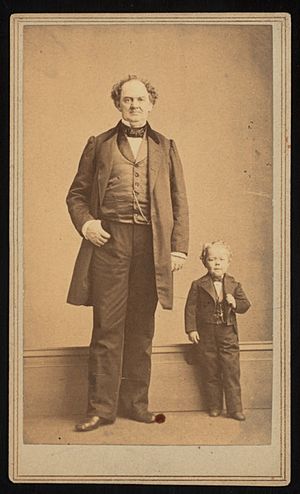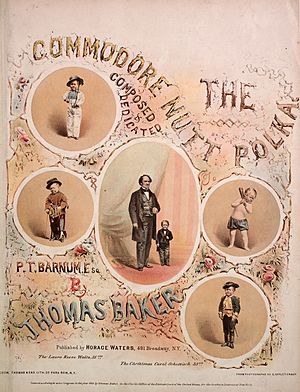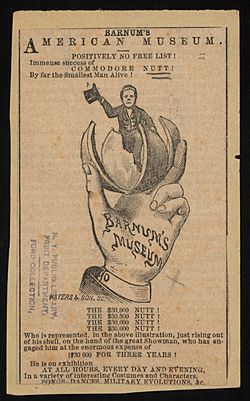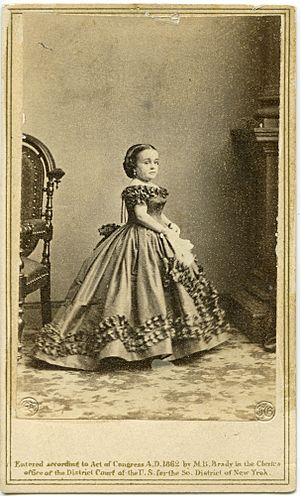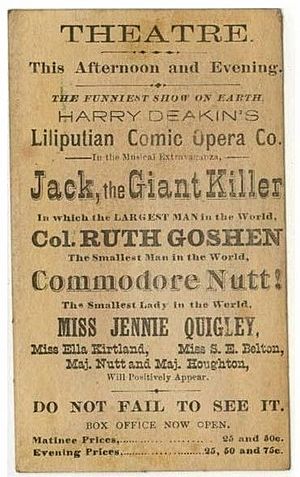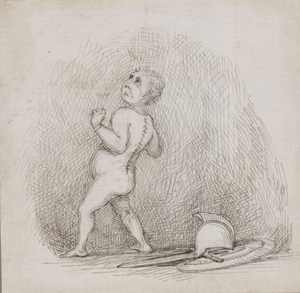Commodore Nutt facts for kids
Quick facts for kids
Commodore Nutt
|
|
|---|---|

Commodore Nutt in uniform, about 1865
|
|
| Born |
George Washington Morrison Nutt
April 1, 1848 Manchester, Hillsborough County, New Hampshire, United States of America
|
| Died | May 25, 1881 (aged 33) |
| Cause of death | Bright's disease |
| Resting place | Uncertain, but probably Merrill Cemetery, Manchester, New Hampshire |
| Nationality | American |
| Occupation | Entertainer |
| Employer | P. T. Barnum |
| Known for | Rivaling General Tom Thumb for the hand of Lavinia Warren |
| Height | 29–30 in (at his 1862 debut) 42 in (at his death) |
| Spouse(s) | Lilian Elston of Redwood City, California |
| Children | None known |
| Parent(s) | Major Rodnia Nutt Maria (Dodge) Nutt |
| Relatives | James Dodge Nutt (brother) Rodnia Nutt, Jr. (brother) Mary Ann Nutt (sister) |
Commodore Nutt (born George Washington Morrison Nutt; April 1, 1848 – May 25, 1881) was a famous American entertainer. He was born in New Hampshire. Commodore Nutt was a dwarf. In 1861, he was performing with a circus in New England. That's when P. T. Barnum hired him. Barnum was a well-known showman.
Nutt began performing at Barnum's American Museum in New York City. Barnum gave him the stage name Commodore Nutt. He also gave him special naval uniforms and a tiny carriage. This carriage looked like an English walnut. Nutt quickly became one of the museum's biggest stars.
Nutt was interested in Lavinia Warren, another dwarf at the museum. Lavinia was older than Nutt. She saw him as a "nice little boy." In 1863, she married General Tom Thumb. This was a huge wedding planned by Barnum. Nutt was Thumb's best man. After this, Nutt stayed away from women for a long time. In 1879, he married Lilian Elston from Redwood City, California.
From 1869 to 1872, Nutt traveled the world. He toured with the Thumbs and Lavinia's sister, Minnie Warren. They performed for royalty and returned to America very rich. Nutt later left Barnum's company after a disagreement. He performed with a comic opera group. He also created a variety show on the West Coast. For a short time, he ran saloons in Oregon and California. He returned to New York City and died there in May 1881 from a kidney illness.
Contents
Early Life and Family
George Washington Morrison Nutt was born on April 1, 1848. His parents were Major Rodnia Nutt (1810–1875) and Maria (Dodge) Nutt (1807–1859). They lived in Manchester, New Hampshire. Rodnia Nutt was a wealthy farmer. He also served as a city marshal and councilman in Manchester.
The Nutt family had five children. George was the youngest. His older brothers were James Dodge and Rodnia, Jr. He also had an older sister, Mary Ann. George and his brother Rodnia, Jr. were both dwarfs. In 1861, Rodnia, Jr. was about 49 inches (124 cm) tall. George was about 29 inches (74 cm) tall and weighed about 25 pounds (11 kg).
Working with P. T. Barnum
Commodore Nutt's career as an entertainer might have started in 1854. He may have performed with a small circus in Manchester. P. T. Barnum heard about Nutt in 1861. At that time, Nutt was touring New England with a manager named Lillie. Barnum thought Lillie was not promoting the boy well.
Barnum met Nutt when the boy visited the American Museum in New York City. Barnum described Nutt as a "remarkable dwarf." He said Nutt was smart, funny, and very attractive. Barnum knew Nutt could be a huge star.
Barnum hired a lawyer to get Nutt to join his museum. The lawyer offered Nutt's parents a lot of money. They signed a five-year contract on December 12, 1861. Barnum agreed to provide food, clothing, and a place to live for George and his brother Rodnia, Jr. He also promised to pay for their travel and medical care. Barnum also said he would make sure the brothers received a good education.
The brothers started with a salary of $12 per week. Their pay increased each year. In their fifth year, they would each earn $30 per week. They also received 10% from selling their souvenir books and photos. At the end of the contract, Barnum promised them a carriage and two ponies.
Becoming Famous
After signing the contract, Barnum started a big advertising campaign. He made it seem like he was trying hard to hire Nutt. Other showmen heard this and offered Nutt's parents even more money. Barnum was happy because this created a lot of excitement. He even claimed he paid $30,000 to hire Nutt. This made the boy known as "The $30,000 Nutt."
Barnum gave the dwarf the stage name Commodore Nutt. He also gave Nutt tiny naval uniforms. For trips around New York, Barnum had a small carriage built for Nutt. This carriage looked like an English walnut. The top of the carriage opened up so people could see the little Commodore inside.
Nutt's carriage was pulled by Shetland ponies. Rodnia, Jr. drove it around New York, dressed as a coachman. Barnum believed these trips were the best way to advertise. Today, Nutt's carriage is in the Barnum Museum in Bridgeport, Connecticut.
First Performance
Commodore Nutt first performed at Barnum's American Museum in February 1862. He was a huge success. However, some visitors thought Barnum was tricking them. They believed Nutt was actually General Tom Thumb in disguise.
Nutt did look like the younger Tom Thumb. But Thumb had grown older and gained weight over the years. Nutt enjoyed the confusion and even encouraged people to think he was Thumb.
Tom Thumb was touring when Nutt debuted. Barnum wanted to prove that Nutt was a different person. He asked Thumb to return to New York and perform with Nutt. Thumb came back, and the two little men performed together. They were called "The Two Dromios" and "The Two Smallest Men, and Greatest Curiosities Living." This show opened on August 11, 1862. Even then, some people still thought Nutt was Thumb in disguise. Barnum found it amusing how people could trick themselves.
About two months after his debut, Nutt met with New York City police officers. He applied for and received a policeman's job. He even ordered a uniform. He sent a telegram to the police, saying he had joined the Broadway Squad with "extraordinary powers to arrest" people outside the museum.
Meeting President Lincoln
In November 1862, President Abraham Lincoln invited Barnum and Nutt to the White House. Lincoln paused a meeting to greet them. Nutt asked Salmon P. Chase, the Secretary of the Treasury, if he was the one spending so much of Uncle Sam's money. Edwin M. Stanton, the Secretary of War, interrupted to say he was. Nutt replied, "Well, it is in a good cause, anyhow, and I guess it will come out all right."
As they left, President Lincoln shook Nutt's hand. He told the Commodore to "wade ashore" if his "fleet" was ever in danger. Nutt looked at Lincoln's long legs. "I guess, Mr. President," he said, "You could do that better than I could."
Love and Weddings
Lavinia Warren
Mercy Lavinia Warren Bump was a dwarf who used to teach school. Barnum hired her in 1862. Her name was shortened to Lavinia Warren. She first appeared at the museum in 1863. Lavinia was 21 years old, 32 inches (81 cm) tall, and weighed 29 pounds (13 kg). Barnum called her "The Queen of Beauty." Nutt quickly developed a crush on her.
Barnum gave Lavinia a diamond and emerald ring. It was too big for her, so he told her to give it to Nutt as a sign of friendship. Nutt thought the ring meant she loved him. He fell even more in love. Lavinia felt uncomfortable with his attention. She saw herself as a grown woman, but thought of Nutt as just a "nice little boy."
General Tom Thumb met Lavinia when he visited the museum in late 1862. He told Barnum that day that he had fallen in love with her. Thumb wanted Barnum's support in this romance. He secretly promised Barnum he would marry Lavinia in a public ceremony. Barnum immediately knew this would be a huge event and make a lot of money. He told Lavinia to take Thumb's interest seriously and reminded her that Thumb was rich.
A Rival for Love
Nutt knew Thumb was in love with Lavinia and became jealous. He even had a fight with Thumb in a dressing room at the museum. He threw Thumb to the floor and beat him. Nutt invited himself to Barnum's home for a weekend visit with Lavinia. He didn't know that Thumb and his mother would also be there.
Nutt arrived late on Saturday night. He found Thumb and Lavinia alone in the parlor. Thumb had proposed, and Lavinia had accepted. Nutt only learned about their engagement a week later when Lavinia and Barnum told him. Nutt found it hard to forgive Thumb and Barnum for what he called a "dastardly offense."
The "Fairy Wedding"

Barnum thought Lavinia's younger sister, Minnie, would be a good match for Nutt. He asked Nutt to consider marrying Minnie. Nutt told Barnum he didn't trust women and wouldn't marry "the best woman living."
Barnum wanted Minnie and Nutt to be the bridesmaid and best man at Lavinia and Thumb's wedding. Nutt first refused. Later, Thumb himself asked Nutt to be his best man, and Nutt accepted. He told Barnum, "It was not your business to ask me. When the proper person invited me, I consented."
Thumb and Lavinia were married at Grace Episcopal Church in New York City on February 10, 1863. Nutt and Minnie were the best man and bridesmaid at this "Fairy Wedding." Police stopped traffic as crowds gathered to see the wedding party arrive. Two thousand people were invited, including many important guests. Some church members complained about the "marriage of mountebanks" (performers).
The wedding reception was held at the Metropolitan Hotel. The four little members of the wedding party stood on a grand piano so everyone could see them. Nutt gave Lavinia a diamond ring as a wedding gift. Americans loved the wedding. It was a welcome break from the sadness of the ongoing war.
World Tours and Later Life
People around the world were very interested in the wedding. Barnum saw this as a chance to make more money. He sent the wedding party on long, successful tours across America and Europe. The four dwarfs then began a grand world tour as The Tom Thumb Company.
They left the United States on June 21, 1869. They traveled 60,000 miles around the world. They visited 587 cities and towns. They gave 1,471 performances of songs, speeches, and military drills. They returned to America in 1872. After the tour, Nutt and Barnum had a disagreement, and Nutt left. He joined another company that performed a comic opera called Jack, the Giant Killer.
Nutt and his brother Rodnia later created a variety show in Portland, Oregon, but it was not successful. Nutt then went to San Francisco, California, and started another show. He soon grew tired of performing. Other shows he tried to create also failed. Nutt also tried running a few saloons in Oregon and San Francisco, but these businesses were not successful either.
Final Years and Death
Newspapers reported several times that Nutt and Minnie Warren were married. They were close friends, but they never married. Minnie married a performer named Edward Newell. She died in 1878 while having a baby.
Long after the Thumbs' wedding, Barnum asked Nutt why he hadn't married. Nutt said he had decided not to marry until he was thirty. He also said that his bride's height didn't matter, but he preferred "a good, green country girl."
In 1879, Nutt married Miss Lilian Elston from Redwood City, California. He had met her while touring the American West. She was a bit shorter than most women, but she was not a dwarf.
After his business failures on the West Coast, Nutt returned to New York City. He bought a saloon, but it was closed by the courts. For a time, Nutt managed an amusement area called Rockaway Pier. He also returned to performing with an act called "Tally-Ho."
In early 1881, Nutt became sick with a kidney illness (Bright's disease). He was ill for over two months. He died on May 25, 1881, at the Anthony House in New York City. At his funeral, Nutt's wife cried over his coffin. She called him her "dear little boy" and said he was "so good." Nutt was buried in Merrill Cemetery in Manchester, New Hampshire.
Nutt had grown from his original 29 inches (74 cm) to about 42 inches (107 cm) by the time of his death. He weighed a little less than 70 pounds (32 kg). In 1891, the editors of Appleton's Cyclopedia wrote that Commodore Nutt was known for his "large-hearted virtues." They said his kind nature, loyalty, and generosity earned him great respect. They also noted that Nutt was "for many years faithful to an early love."
Images for kids
See also
 In Spanish: Comodoro Nutt para niños
In Spanish: Comodoro Nutt para niños


